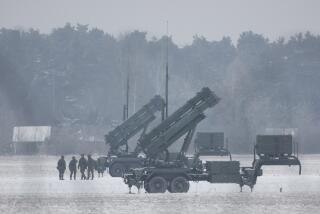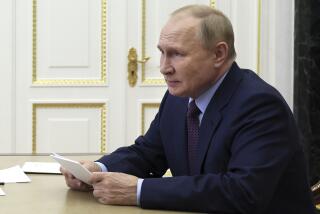Pentagon’s Secret Spending Reaches Post-Cold War High
- Share via
WASHINGTON — The Pentagon’s spending on secret programs has hit its highest level since the end of the Cold War, a Washington-based research group said in a report released last week.
Classified programs appear to account for about $30.1 billion, or 19%, of the acquisition funds sought in the Defense Department budget for fiscal 2007, according to the report by the Center for Strategic and Budgetary Assessments.
In real terms, the 2007 request was for more classified spending than in any defense budget since 1988, near the Cold War’s end, when the Pentagon received an inflation-adjusted $29.4 billion for such projects, the report says.
Classifying Pentagon programs means they get less oversight by Congress, watchdog groups and the media.
The record of such programs has been mixed, said Steven Kosiak, the report’s author, noting that the F-117 “Stealth” fighter jet and the radar-evading B-2 bomber were among the successes.
But reduced oversight has led to failures, such as the U.S. Navy’s A-12 attack aircraft, canceled in 1991, Kosiak noted.
Secret programs also have tended to spawn “fringe science” -- anti-matter weapons, psychics and telepathy -- because they were protected from outside scrutiny, said Sharon Weinberger, author of “Imaginary Weapons: A Journey through the Pentagon’s Scientific Underworld.”
Weinberger contends that the Defense Department, citing a need for secrecy to protect national security, is in effect shielding “bad science” from peer review at a net loss to taxpayers.
In his study, Kosiak said classified funding sought for Pentagon purchases had more than doubled in real terms since fiscal 1995, when it reached a post-Cold War low.
Since 1995, funding for classified acquisition programs has grown at a faster rate than funding for acquisition programs overall -- up 64% in real terms, the report said.
The Air Force’s fiscal 2007 budget request contained the biggest share of the Pentagon’s classified acquisition funding -- more than 75% of the total.
Classified programs account for about 44%, or $14.1 billion, of the Air Force’s procurement request and 39%, or $9.6 billion, of its research and development request, Kosiak said, citing Pentagon budget documents.
More to Read
Sign up for Essential California
The most important California stories and recommendations in your inbox every morning.
You may occasionally receive promotional content from the Los Angeles Times.













